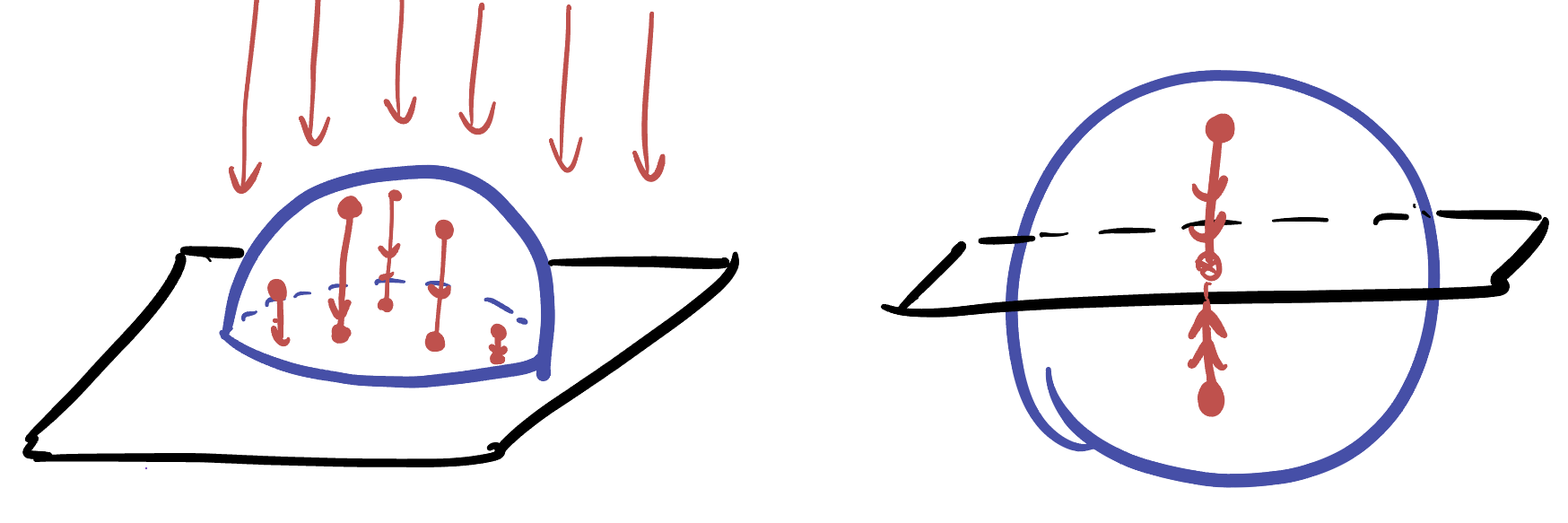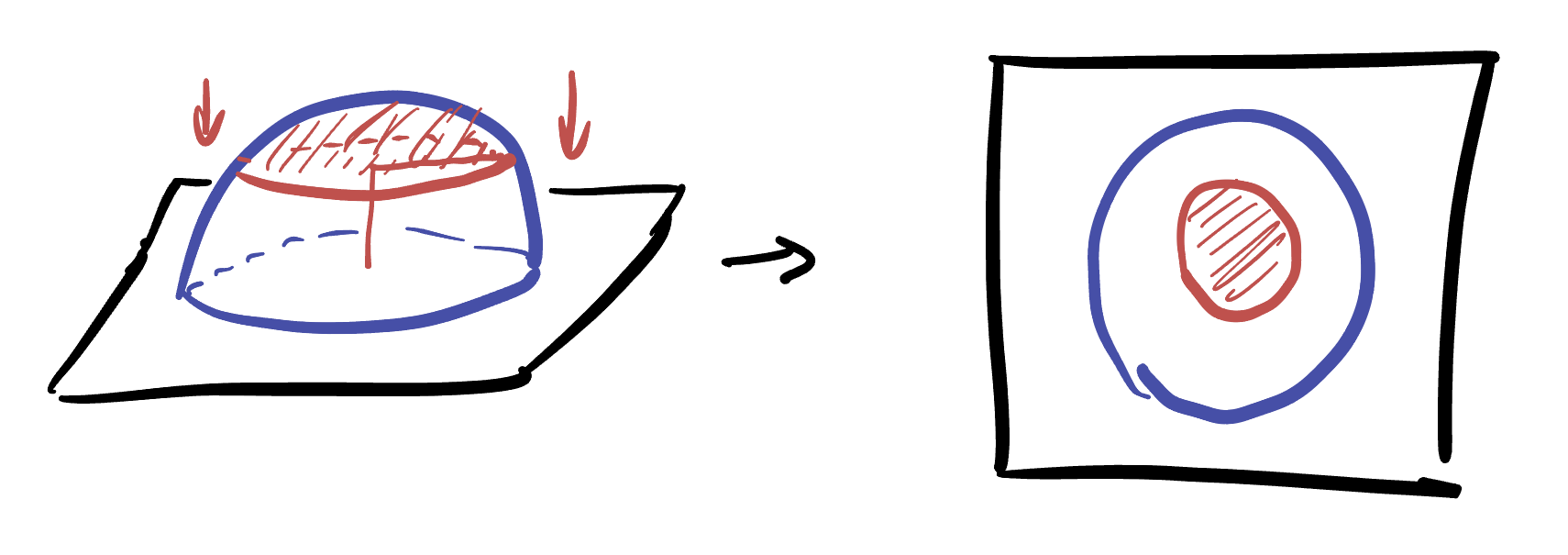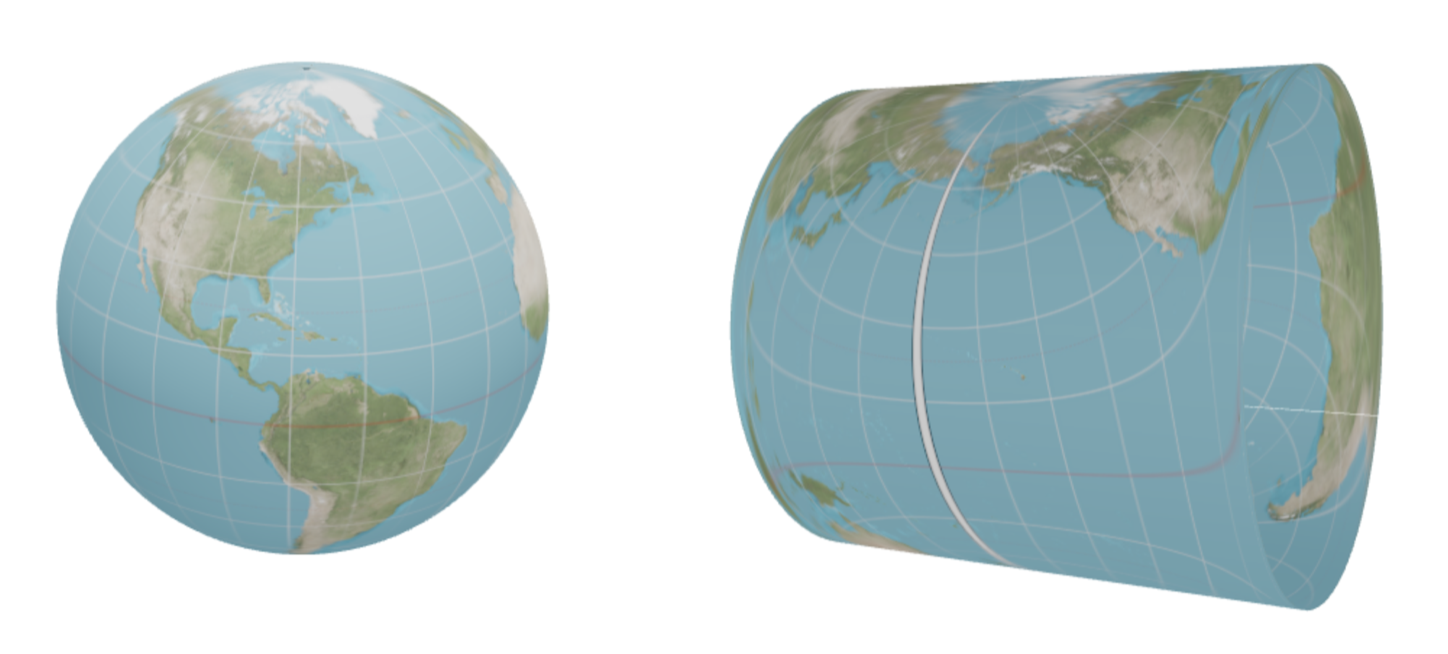22 Examples
In this chapter we will apply some of the theory we developed to work with some well-known map projections used for depicting the earth. This is a slight digression from the logical flow of our text, as none of this work is strictly needed for anything that follows (and those interested in the purely mathematical story can move immediately to the next chapter, stereographic projection, where we apply these same techniques to the map we will use the most).
However, taking a brief look at examples serves two purposes: one, it will help us become more comfortable with the theory of maps, as we will do several explicit computations:
- We will calculate the map-length of a curve in the Orthographic projection.
- We will calculate the map-area of regions in Archimedes map, and show it is area preserving.
- We will compute angles in the Mercator map, and show it is angle preserving
And two; the study of maps is a beautiful application of mathematics to the wider human world - we might as well take a look - just for cultural reasons - while we are so nearby.
22.1 Orthographic Projection
To write down a map we need to give its chart: a map
We can picture such a map as the vertical orthogonal projection of space onto the

This cannot give a map of the entire earth at once, as each vertical line that intersects the sphere off the equator hits it in two points

Definition 22.1 (Orthographic Map) Let the region

Before delving into the quantitative calculus, let’s try to develop a bit of a qualitative understanding of this map. Here’s two facts we can see directly from its definition:
- Geodesics through the north pole
- Circles about the north pole
To see the first point, note that (1) geodesics on the sphere are great circles, which are the intersection of
To see the second point, recall that the circle of radius

This has the consequence that the equator of the sphere also maps to a circle on the plane - its the unit circle bounding our map
Remark 22.1. This implies that other geodesics of the sphere necessarily are represented by some curves that interpolate between straight lines and circles: not all geodesics are going to look like easy-to-understand curves in our map! That’s one of the distortions we will have to learn to live with.
To get any quantitative understanding of this map, the first step is to take the derivative of the parameterization
Remark 22.2. When working with such a map, its often easiest to recall that
This derivative matrix is the key to all further calculation. From it we can directly compute map-lengths of vectors and curves, map-angles, and map-areas following the general theory.
Example 22.1 (Orthographic Map-Length of
To see this, notice that
Knowing the infinitesimal lengths in the
Exercise 22.1 The map-length of the curve
To see this, recall that the map length of
Because
Integrating this gives a familiar expression: we saw this exact integral in the definition of the arc cosine function (Proposition 14.2)! Since
Beyond applying this just to the basis vector
Example 22.2 (Orthographic Map Infinitesimal Lengths) If
We calculate this by applyign
Computing the length, we get
Knowing the map-length of an arbitrary vector on
Example 22.3 (Orthographic Map Disks) At the point
At the center of our map where
and after a bit of simplification, we find
This is an ellipse! Thus, we see at

Since it’s affecting the two directions unequally, we expect that it will not be preserving angles very well, so let’s confirm.
Example 22.4 (Orthographic Map Angle) The vectors
To see this, all we need to do is compute the map-dot-product between
These are the two true vectors that
Thus, whenever
Exercise 22.2 Can you find the coordinates
Hint: can you make the problem easier for yourself by restricting
You can see how this would make such a map difficult to use for navigation: it would look like the map is telling you to turn
22.2 Archimedes’ Map
In Archimedes’ most cherished work The Sphere and the Cylinder, he proved that the surface area of the sphere and the cylinder agreed by showing that horizontally projecting the surface of the sphere onto the cylinder preserved infinitesimal areas, and thus (via integration) the total area. This suggests a means of creating a map of the earth which displays the true areas for each region: first project horizontally onto the surrounding cylinder, then unroll the cylinder onto the plane.

For step 1, what happens when we horizontally map a point
How do we find this scaling factor
We can then use the fact that
Now, we just need to unroll the cylinder onto the plane: this means we continue to leave the height, or

Definition 22.2 (Archimedes’ Map) Let
and its inverse, Archimedes’ parameterization
In cartography, this map is not named after Archimedes but rather the 17th century mapmaker Lambert, and called the Lambert Cylindrical projection, or the Lambert Equal-Area projection.


While it is natural to us earthlings to project the earth onto a cylinder whose axis passes through the north and south poles, it is by no means necessary: the sphere is homogeneous after all! So there are many unfamiliar maps that can be produced by this technique, sharing all the same mathematical properties. Here we illustrate just one option, unrolling along an axis through the equator.


To understand what Archimedes map does to regions of the sphere, a useful spot to start is to calculate its map-disks (Tissot’s Indicatrices) and see what shape they are!
Theorem 22.1 (Archimedes Map Disks) At the point
Proof. We calculate this by just applying
Exercise 22.3 Do this calculation!
Because essentially all calculations require us to know infinitesimal information about the parameterization (translating vectors on the map to their true counterparts on the sphere), we begin with a calculation of

The map-disks are ellipses, meaning that angles in general are not preserved. However, we can calculate the area of these map-disks to understand better the area distortion (or lack thereof) on the map. The ellipses we found turn out to be lined up nicely along the two axes of
Theorem 22.2 (Archimedes Map is Area Preserving) At every point
Proof. If an ellipse has radii
Because we are still learning how to compute effectively with maps, we’ll give a second proof of this fact, where we do not bother working out the details of our map disks, but rather just directly look at infinitesimal lengths are areas, figuring out what happens to an infinitesimal unit square.
Exercise 22.4 Give a second proof that Archimedes map is area-preserving, that looks at infinitesimal squares instead of ellipses. Show that at each point
Now only does this immediately imply archimedes overall result that the two areas are equal (each area is by definition the integral of its infinitesimal areas, and we just showed all the infinitesimal areas are equal), but it also shows that the area of any region on the map accurately portrays the true area of the region it represents on the sphere.
Theorem 22.3 Let
Proof. Because the chart and parameterization are inverses, we could just as well call
But now we know that
However, its important not to forget what we learned along the way: the map-disks for Archimedes map form extremely distorted ellipses as one approaches the poles: with horizontal length stretching near infinite and vertical height crushing to zero. This map massively distorts the shapes of regions, distances between points and angles between curves in its attempt to preserve area. Like the orthographic map before it, this makes Archimedes’ map unsuitable for navigational tasks, where figuring out accurately what direction you must go to reach your desired destination is of utmost importance.
22.3 Equirectangular Projection
There is an entire collection of maps which are defined as modifications of Archimedes’ original idea, these days called cylindrical projections as they start by projecting onto a cylinder. Perhaps the two most common of these are the Mercator projection (discussed in the next chapter as a potential final project opportunity), and the Equirectangular projection, which I will only briefly mention here (for anyone who is doing a final project on Maps and would like another, easy-to-compute-with and yet still real-world example).
The problem the Equirectangular projection tries to solve is the vertical distortion of Archimedes’ map. Archimedes made the vertical height on the map equal the vertical height of the sphere at that point: this clever move ensured area was preserved, but what if we wanted the vertical height on the map to actually be related to the north-south distance? Archimedes’ map fails badly at this, as we see in the picture above.
What we want from our new map projection is that it
- Continues to be a cylindrical projection
- Distance along the (vertical)
Because we are still projecting onto a cylinder, the chart for such a map is still going to have
Definition 22.3 The chart for the equirectangular projection is defined on the region
by the chart function
Exercise 22.5 Derive the parameterization for the Equirectangular projection.


Exercise 22.6 Spherical coordinates in mathematics and physics are almost the same as the equirectangular projection: the only difference being a convention on where to measure the angle
Write down the chart and parameterization for spherical coordinates, and see that it is what you are taught in multivariable calculus!
Because this map captures distance accurately along the equator, as well as north-south distance along lines of longitude, it is an easy map to work with, and has become the default map in many contexts.
Exercise 22.7 Find the important map-quantities in the equirectangular projection:
- Find the map-length of a vector
- Find the equation for the map-disk at
- Does this map preserve angle?
- Find the map-area: since horizontal and vertical lines in
